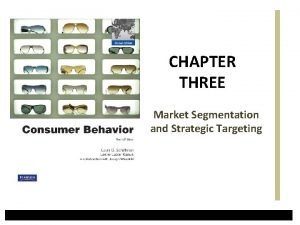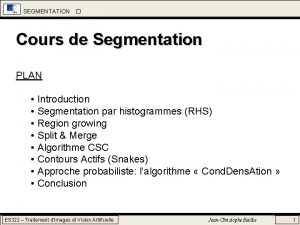Chapter Three MARKET SEGMENTATION What is the market












- Slides: 12

Chapter Three MARKET SEGMENTATION

What is the market segmentation? Market segmentation can be defined as the process of dividing a market into distinct subsets of consumers with common needs or characteristics and selecting one or more segments to target with a distinct marketing mix. Before the widespread acceptance of market segmentation, the prevailing way of doing business with consumers was through mass marketing-that is, offering the same product and marketing mix to all consumers. The essence of this strategy was summed up by the entrepreneur Henry Ford, who offered the Model T automobile to the public "in any color they wanted, as long as it was black. " Who uses market segmentation? Because the strategy of market segmentation benefits both the consumer and the marketer, marketers of consumer goods are eager practitioners. How does market segmentation operate? Segmentation studies are designed to discover the needs and wants of specific groups of consumers, so that specialized goods and services can be developed and promoted to satisfy each group's needs. Many new products have been developed to fill gaps in the marketplace revealed by segmentation research.

MARKET SEGMENTATION CATEGORIES AND SELECTED VARIABLES SEGMENTATION BASE SELECTED SEGMENTATION VARIABLES GEOGRAPHIC SEGMENTATION Region Southwest, Mountain states, Alaska, Hawaii City size Major metropolitan areas, small cities, towns Density of area Urban, suburban, exurban, rural Climate Temperate, hot, humid, rainy DEMOGRAPHIC SEGMENTATION Age Under 12, 12 -17, 18 -34, 35 -49, 50 -64, 65 -74, 75 -99, 100+ Sex Male, female Marital status Single, married, divorced, living together, widowed Income Under $25, 000, $25, 000 -$34, 999, $35, 000 -$49, 999, $50, 000 -$74, 999, $75, 000 -$99, 999, $100, 000 -$149, 000, $150, 000 and over Education Some high school, high school graduate, some college, college graduate, postgraduate Occupation Professional, blue-collar, white-collar, agricultural, military PSYCHOLOGICAL SEGMENTATION Needs-motivation Shelter, safety, security, affection, sense of slf-worth Personality Extroverts, novelty seekers, aggressives, innovators Perception Low-risk, moderate-risk, high-risk Learning-involvement Low-involvement, high-involvement Attitudes Positive attitude, negative attitude

MARKET SEGMENTATION CATEGORIES AND SELECTED VARIABLES/Cont…. . SEGMENTATION BASE SELECTED SEGMENTATION VARIABLES PSYCHOGRAPHIC (Lifestyle) Segmentation Economy-minded, couch potatoes, outdoors enthusiasts, status seekers SOCIOCULTURAL SEGMENTATION Cultures American, Greek, Chinese, German, Mexican, French, Pakistani Religion Catholic, Protestant, Moslem, Jewish, other Subcultures (race/ethnic) African American, Caucasian, Asian, Hispanic Social class Lower, middle, upper Family life cycle Bachelors, young married, full nesters, empty nesters USE-RELATED SEGMENTATION Usage rate Super heavy users, medium users, light users, nonusers Awareness status Unaware, interested, enthusiastic Brand loyalty None, some, strong

MARKET SEGMENTATION CATEGORIES AND SELECTED VARIABLES/Cont……. SEGMENTATION BASE SELECTED SEGMENTATION VARIABLES USE-SITUATION SEGMENTATION Time Leisure, work, rush, morning, night Objective Personal, gift, snack, fun, achievement Location Home, work, friend's home, in-store Person Self, family members, friends, boss, peer BENEFIT SEGMENTATION Convenience, social acceptance, long lasting, econoly, value-forthe-money HYBRID SEGMENTATION Demographic/psychographic Combination of demographic and psychographic profiles of consumer segments profiles PRIZM NE (Geo-demographics) "Movers & Shakers, " "New Empty Nests, " "Boomtown Singles, " "Bedrock America" SRIVALSTM Innovators, Thinkers, Believer, Achievers, Strivers, Experiencer, Makers, Survivors

MALE AND FEMALE SEGMENTS OF INTERNET USERS KEY USAGE SITUATION FAVORITE INTERNET MATERIALS Social Sally Making friends Chat and personal Web page New Age Crusader Fighting for causes Books and government information Cautious Mom Nurturing children Cooking and medical facts Playful Pretender Role-playing Chat and games Master Producer Job productivity White pages and government information Bits and Bytes Computers and hobbies Investments, discovery, software Practical Pete Personal productivity Investments, company listings Viking Gamer Competing and winning Games, chat, software Sensitive Sam Helping family and friends Investments, government information World Citizen Connecting with world Discovery, software, investments FEMALE SEGMENTS

BASES OF SEGMENTATION Psychological segmentation: Psychological characteristics refer to the inner or intrinsic qualities of the individual consumer. Consumer segmentation strategies are often based on specific psychological variables. For instance, consumers may be segmented in terms of their motivations, personality, perceptions, learning, and attitudes. Psychographic segmentation: Marketing practitioners have heartily embraced psychographic research, which is closely aligned with psychological research, especially personality and attitude measurement. This form of applied consumer research (commonly referred to as lifestyle analysis) has proven to be a valuable marketing tool that helps identify promising consumer segments that are likely to be responsive to specific marketing messages. Socio-cultural segmentation: Sociological (group) and anthropological (cultural) variables-that is, socio-cultural variables-provide further bases for market segmentation.

BASES OF SEGMENTATION /Cont…. Family life cycle: Family life-cycle segmentation is based on the premise that many families pass through similar phases in their formation, growth, and final dissolution. At each phase, the family unit needs different products and services. Young single people, for example, need basic furniture for their first apartment, whereas their parents, finally free of child rearing, often refurnish their homes with more elaborate pieces. Family life cycle is a composite variable based explicitly on marital and family status but implicitly reflects relative age, income, and employment status. Social class: Social class (or relative status in the community) can be used as a base for market segmentation and is usually measured by a weighted index of several demographic variables, such as education, occupation, and income. The concept of social class implies a hierarchy in which individuals in the same class generally have the same degree of status, whereas members of other classes have either higher or lower status. Studies have shown that consumers in different social classes vary in terms of values.

BASES OF SEGMENTATION /Cont…. Culture and subculture: Marketers who use cultural segmentation stress specific, widely held cultural values with which they hope consumers will identify (e. g. , for American consumers, youthfulness and fitness and health). Cultural segmentation is particularly successful in international marketing, but it is important for the marketer to understand fully the target country's beliefs, values, and customs (the cross-cultural context). Cross-cultural or global marketing segmentation: As the world has gotten smaller and smaller, a true global marketplace has developed. For example, as you read this you may be sitting on an IKEA chair or sofa (Sweden), drinking Earl Grey tea (England), wearing a Swatch (Switzerland), Nike sneakers (China), a Polo golf shirt (Mexico), and Dockers pants (Dominican Republic).

SUMMARY DIAGRAM OF SRI VALSTM SEGMENTS INNOVATORS Achievement High Resources High Innovation Self-Expression ACHIEVERS EXPERIENCERS Primary Motivation Ideals THINKERS BELIEVERS MAKERS SURVIVORS STRIVERS Low Resources Low Innovation

A BRIEF DESCRIPTION OF THE EIGHT VALSTM NEW EDITION SEGMENTS INNOVATORS Innovators are successful, sophisticated, take-charge people with high selfesteem. Because they have such abundant resources, they exhibit all three primary motivations in varying degrees. They are change leaders and are the most receptive to new ideas and technologies. Their purchases reflect cultivated tastes for upscale, niche products and services. THINKERS: Motivated by ideals; high resources Thinkers are mature, satisfied, comfortable, and reflective. They tend to be well educated and actively seek out information in the decision-making process. They favor durability, functionality, and value in products. BELIEVERS: Motivated by ideals; low resources Believers are strongly traditional and respect rules and authority. Because they are fundamentally conservative, they are slow to change and technology averse. They choose familiar products and established brands. ACHIEVERS: Motivated by achievement; high resources Achievers have goal-oriented lifestyles that center on family and career. They avoid situations that encourage a high degree of stimulation or change. They prefer premium products that demonstrate success to their peers.

A BRIEF DESCRIPTION OF THE EIGHT VALSTM NEW EDITION SEGMENTS/Cont……. . STRIVERS Motivated by achievement; low resources Strivers are trendy and fun loving. They have little discretionary income and tend to have narrow interests. They favor stylish products that emulate the purchases of people with greater material wealth. EXPERIENCERS Motivated by self-expression; high resources Experiencers appreciate the unconventional. They are active and impulsive, seeking stimulation from the new, offbeat, and risky. They spend a comparatively high proportion of their income on fashion, socializing, and entertainment. MAKERS Motivated by self-expression; low resources Makers value practicality and self-sufficiency. They choose hands-on constructive activities and spend leisure time with family and close friends. Because they prefer value to luxury, they buy basic products. SURVIVORS Survivors lead narrowly focused lives. Because they have the fewest resources, they do not exhibit a primary motivation and often feel powerless. They are primarily concerned about safety and security, so they tend to be brand loyal and buy discounted merchandise.
 Marketing segmentation targeting positioning
Marketing segmentation targeting positioning Three market segmentation strategies
Three market segmentation strategies Consumer rooted segmentation
Consumer rooted segmentation Market leader challenger follower nicher
Market leader challenger follower nicher Market segmentation images
Market segmentation images Market segmentation template
Market segmentation template Kfc segmentation targeting positioning
Kfc segmentation targeting positioning Bases of market segmentation
Bases of market segmentation Nivea market segmentation
Nivea market segmentation What are the requisites of sound market segmentation
What are the requisites of sound market segmentation Pringles brown
Pringles brown Bases of market segmentation
Bases of market segmentation Health insurance market segmentation
Health insurance market segmentation























